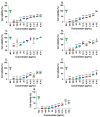Phenolic Composition, Antioxidant, and Anti-Proliferative Activities Against Human Colorectal Cancer Cells of Amazonian Fruits Copoazú (Theobroma grandiflorum) and Buriti (Mauritia flexuosa)
- PMID: 40142027
- PMCID: PMC11944506
- DOI: 10.3390/molecules30061250
Phenolic Composition, Antioxidant, and Anti-Proliferative Activities Against Human Colorectal Cancer Cells of Amazonian Fruits Copoazú (Theobroma grandiflorum) and Buriti (Mauritia flexuosa)
Abstract
Amazonian fruits are a source of bioactive compounds, among which phenolic compounds, flavonoids, and carotenes stand out. These compounds play a crucial role in restoring oxidative balance, consequently reducing the proliferation of cancer cells. However, the content of these metabolites and their biological properties may vary significantly depending on the geographical location and the environmental conditions where plants grow. This research assessed the content of metabolites, free radical scavenging capacity, and hemolytic and antiproliferative effects of the hydro-methanolic extracts of the Amazonian fruits Theobroma grandiflorum and Mauritia flexuosa. The results revealed that the extracts derived from the seeds of Theobroma grandiflorum sourced from the Balcanes experimental farm and the pulp of Mauritia flexuosa harvested in Florencia exhibited higher contents compared to other analyzed sites: Total phenolic content (TPC) (619.41 ± 12.05 and 285.75 ± 10.06 mg GAE/100 g FW), Total flavonoid content (TFC) (569.09 ± 4.51 and 223.21 ± 3.92 mg CAT/100 g FW), and Total carotenoid content (TCC) (25.12 ± 0.16 and 48.00 ± 0.28 mg eq β-carotene/100 g FW), respectively. Also, these samples demonstrated superior scavenging capacities for the ABTS and DPPH radicals, while the peel of Mauritia flexuosa exhibited the highest scavenging capacity for the oxygen radical (526.23 ± 2.08 µmol Trolox.g-1). The hemolytic effect shows dose-dependent responses with IC50 values of 27.73 μg/mL for the Balcanes seeds and 1.27 μg/mL for the Florencia pulp. Furthermore, it was observed that treatment with the fruit-derived extracts effectively reduced the number of viable human colorectal cancer cells, using SW480 ATCC cell line, demonstrating a non-dose-dependent behavior compared to the control cells.
Keywords: Mauritia flexuosa; Theobroma grandiflorum; antioxidant; antiproliferative.
Conflict of interest statement
The authors declare no conflicts of interest. The funders had no role in the design of the study, in the collection, analyses, or interpretation of data, in the writing of the manuscript, or in the decision to publish the results.
Figures



References
-
- NCI Definición de Cancer—Diccionario de Cáncer del NCI—Instituto Nacional del Cáncer. [(accessed on 6 September 2024)]; Available online: https://www.cancer.gov/espanol/publicaciones/diccionarios/diccionario-ca....
-
- Movahed Z.G., Yarani R., Mohammadi P., Mansouri K. Sustained oxidative stress instigates differentiation of cancer stem cells into tumor endothelial cells: Pentose phosphate pathway, reactive oxygen species, and autophagy crosstalk. Biomed. Pharmacother. 2021;139:111643. doi: 10.1016/j.biopha.2021.111643. - DOI - PubMed
-
- Rahman M.A., Bulbul M.R.H., Kabir Y. Functional Foods in Cancer Prevention and Therapy. Elsevier; Amsterdam, The Netherlands: 2020. Plant-based products in cancer prevention and treatment; pp. 237–259.
-
- Fidelis M., de Oliveira S.M., Santos J.S., Escher G.B., Rocha R.S., Cruz A.G., Carmo M.A.V.D., Azevedo L., Kaneshima T., Oh W.Y., et al. From byproduct to a functional ingredient: Camu-camu (Myrciaria dubia) seed extract as an antioxidant agent in a yogurt model. J. Dairy Sci. 2020;103:1131–1140. doi: 10.3168/jds.2019-17173. - DOI - PubMed
MeSH terms
Substances
LinkOut - more resources
Full Text Sources
Medical
Miscellaneous

